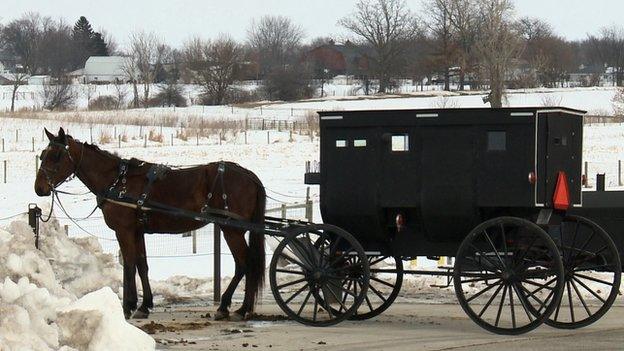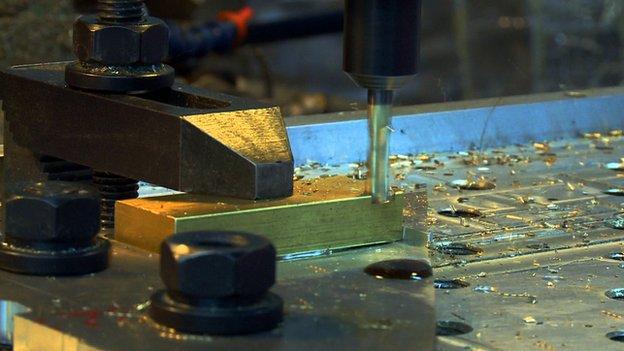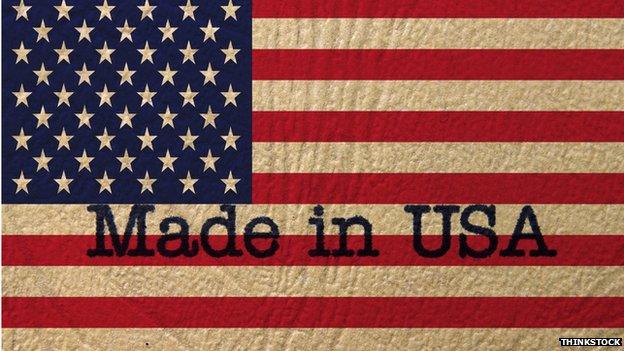Is this American-made leather bag really worth $10,000?
- Published
Steven Fischer says the amount of work which goes into making the bag means the price "is not too high".
Wander round a well-to-do shopping mall or district in any major US city, and you will see lots of stores offering luxury goods. But with a few notable exceptions, most will not be American brands.
Why? One reason, say observers, is that the country no longer produces luxury items on the scale that it used to.
That is partly because the pool of skilled talent needed to make those goods has shrunk enormously: "All that got hollowed out when things started to be outsourced in the 80s through into the 90s," says Peter York, who has advised many large luxury companies.
This phenomenon has occurred across the Western world.
In France, for example, concern about the disappearance of craft skills has resulted in the industry setting up new training schemes, in the hope of reviving interest in artisanship.
So against this backdrop, what Chicago entrepreneur Steven Fischer is trying to do, seems somewhat reckless.

Steven Fischer was inspired by an old leather bag he bought at auction, which was widely admired
He is now selling a hand-crafted luxury leather bag, made entirely in the US. The cost? Just under $10,000 (£6,683).
It all came about when he spotted an old leather bag at an auction, and bought it on the spur of the moment.
"It just spoke to me emotionally," he recalls.
Shortly afterwards he took the bag on a plane journey.
As he disembarked, he noticed that the flight attendants were lining up to talk to him: "I thought, 'Oh, boy, I'm in real trouble now.' But what they told me was: 'Sir, we don't know where you got that bag, but that is the most beautiful bag we've seen in a long time.'"
Mr Fischer says he received similar comments from other people. Eventually he began to ask himself: "What would it take to make a bag like this... not only make it, but make it 100% American?"

Mr Fischer started out by asking horse owners where they bought their saddles and harnesses
At the time, Mr Fischer was teaching a course about fashion at Northwestern University, Illinois. He was also providing advice to various organisations on the luxury industry.
Launching a luxury product, however, was a new departure.
He recalls that almost every supplier he spoke to told him he was crazy.
They said to him: "Look, Steven, if you really want to make money, don't make [it] in the US," he remembers.
Mr Fischer ignored the advice and set off on a quest to find supplies and craftsmen skilled in leather-work, spending months driving across the mid-West.
He began by talking to horse owners, asking them who made their saddles and harnesses.

The entire bag is made in the US, including the metal components
As time passed Mr Fischer managed to build up a network of skilled leather and metal workers, who could make the various components to the exacting standards he was looking for.
Some of the craftsmen belong to Amish communities - Mr Fischer says he finds their work to be of exceptional quality.
However, there are challenges. Some Amish people are reluctant to use modern technologies, such as the internet, so communication can be difficult.
The leather for the bag comes from Horween tannery in Chicago, the last one remaining in the city.
All the effort, time and materials that go into making the bag do not come cheap, with a standard example priced at $9,995.
Mr Fischer says the cost is justified. He believes that if he can make a product of the highest quality, then there are customers out there who will buy it.
Although the business is still small, he hopes that he can make it grow. He is already expanding the product range to include belts.

Experts say that consumers are increasingly interested in where a product has been made
But how much of a market is there for products like this?
Some experts say there is a growing interest in the provenance of goods generally, including luxury products.
"In every luxury market where there are already a lot of luxury consumers, there's always an opportunity for a 'made in' that country [product]", says Milton Pedraza of the Luxury Institute, a New York-based firm that advises large businesses.
However, he adds that skills shortages can make producing handmade, luxury items at scale very difficult.
Another challenge is intense competition. It is a field where the big players in the industry undoubtedly have an edge because they benefit from economies of scale.



Despite the challenges, Mr Fischer remains undaunted.
"This is a huge undertaking - I would never have imagined three or four years ago this is where I would be right now," he says.
"But there's something deep inside which is telling me to continue this and to demonstrate that we can create refined luxury here in the United States."